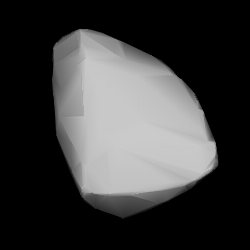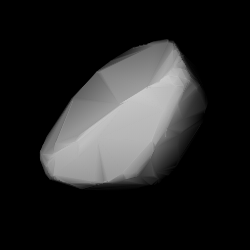Related Research Articles

3325 TARDIS is a dark Alauda asteroid from the outer region of the asteroid belt, approximately 29 kilometers in diameter. It was discovered on 3 May 1984, by American astronomer Brian Skiff at Lowell's Anderson Mesa Station, Arizona, in the United States. The asteroid was named TARDIS, after the fictional time machine and spacecraft from the science fiction television series Doctor Who.
827 Wolfiana, provisional designation 1916 ZW, is a Florian asteroid from the inner regions of the asteroid belt, approximately 8 kilometers in diameter. It was discovered at Vienna Observatory on 29 August 1916, by Austrian astronomer Johann Palisa, who named it after German astronomer Max Wolf. The assumed stony asteroid has a rotation period of 4.0654 hours.
848 Inna is a carbonaceous Themistian asteroid from the outer regions of the asteroid belt. It was discovered on 5 September 1915, by astronomer Grigory Neujmin at the Simeiz Observatory on the Crimean peninsula. The C-type asteroid measures approximately 33 kilometers in diameter, while its rotation period remains unknown. It was named after Russian astronomer Inna Nikolaevna Leman-Balanovskaya (1881–1945).
1751 Herget, provisional designation 1955 OC, is a stony Gefionian asteroid from the central region of the asteroid belt, approximately 11 kilometers in diameter.
1764 Cogshall, provisional designation 1953 VM1, is a carbonaceous Themistian asteroid from the outer regions of the asteroid belt, approximately 26 kilometers in diameter. It was discovered on 7 November 1953, by astronomers of the Indiana Asteroid Program at Goethe Link Observatory in Indiana, United States. The asteroid was named after Wilbur Cogshall, professor of astronomy at Indiana University.
1026 Ingrid, provisional designation 1923 NY, is a stony Florian asteroid and long-lost minor planet (1923–1986) from the inner regions of the asteroid belt, approximately 7 kilometers in diameter. It was discovered by Karl Reinmuth at Heidelberg in 1923, and later named after Ingrid, niece and godchild of astronomer Albrecht Kahrstedt.
1047 Geisha, provisional designation 1924 TE, is a stony Florian asteroid from the inner regions of the asteroid belt, approximately 11 kilometers in diameter. It was discovered on 17 November 1924, by German astronomer Karl Reinmuth at the Heidelberg-Königstuhl State Observatory in southwest Germany. The asteroid was named after the British musical The Geisha.
1581 Abanderada, provisional designation 1950 LA1, is a dark Themistian asteroid from the outer regions of the asteroid belt, approximately 35 kilometers in diameter. It was discovered on 15 June 1950, by Argentine astronomer Miguel Itzigsohn at the La Plata Astronomical Observatory in La Plata, Argentina. The asteroid was named after Eva Perón.

1588 Descamisada, provisional designation 1951 MH, is an Eos asteroid from the outer region of the asteroid belt, approximately 18 kilometers in diameter. It was discovered on 27 June 1951, by astronomer Miguel Itzigsohn at the La Plata Astronomical Observatory in La Plata, Argentina, and named in honor of Eva Perón.
2440 Educatio is a Florian asteroid from the inner regions of the asteroid belt, approximately 6.6 kilometers in diameter. The possibly elongated S-type asteroid has an exceptionally long rotation period of 1561 hours and is one of the slowest rotators known to exist. It was discovered on 7 November 1978, by American astronomers Eleanor Helin and Schelte Bus at the Palomar Observatory in California, and later named "Educatio", the Latin word for Education.
1532 Inari, provisional designation 1938 SM, is a stony Eoan asteroid from the outer regions of the asteroid belt, approximately 28 kilometers in diameter. Discovered by Yrjö Väisälä at Turku Observatory in 1938, it was later named for Lake Inari in northern Finland.
1780 Kippes, provisional designation A906 RA, is an Eoan asteroid from the outer regions of the asteroid belt, approximately 28 kilometers in diameter. It was discovered on 12 September 1906, by astronomer August Kopff at the Heidelberg-Königstuhl State Observatory in southwest Germany. The asteroid was named after German Catholic priest and amateur astronomer Otto Kippes.
1287 Lorcia, provisional designation 1933 QL, is an Eoan asteroid from the outer regions of the asteroid belt, approximately 22 kilometers in diameter. It was discovered by Belgian astronomer Sylvain Arend at the Royal Observatory of Belgium in Uccle on 25 August 1933. The asteroid was named for Laura de Sołohub Dikyj, wife of Polish astronomer Tadeusz Banachiewicz.
1410 Margret, provisional designation 1937 AL, is an Eoan asteroid from the outer regions of the asteroid belt, approximately 21 kilometers in diameter. It was discovered on 8 January 1937, by astronomer Karl Reinmuth at the Heidelberg Observatory in southwest Germany. The asteroid was named after Margret Braun, wife of the Heidelberg astronomer Heinrich Vogt.
1247 Memoria, provisional designation 1932 QA, is a dark Themistian asteroid from the outer regions of the asteroid belt, approximately 37 kilometers in diameter. It was discovered by Marguerite Laugier at Uccle Observatory in 1932, who later named it Memoria in memory of her pleasant stay at the discovering observatory.
2905 Plaskett, provisional designation 1982 BZ2, is a stony Gefionian asteroid from the central regions of the asteroid belt, approximately 10 kilometers in diameter. It was discovered on 24 January 1982, by American astronomer Edward Bowell at the Anderson Mesa Station near Flagstaff, Arizona. The asteroid was named after Canadian astronomers John Stanley Plaskett and Harry Hemley Plaskett.
1711 Sandrine, provisional designation 1935 BB, is a stony Eoan asteroid from the outer region of the asteroid belt, approximately 23 kilometers in diameter.

2384 Schulhof (prov. designation: 1943 EC1) is a mid-sized asteroid and the namesake of the Schulhof family, located in the Eunomian region of the intermediate asteroid belt. It was discovered on 2 March 1943, by French astronomer Marguerite Laugier at Nice Observatory in southeastern France. The asteroid was later named after Hungarian astronomer Lipót Schulhof. The presumed S-type asteroid has a short rotation period of 3.3 hours and measures approximately 12 kilometers (7.5 miles) in diameter.
1861 Komenský, provisional designation 1970 WB, is an Eoan asteroid from the outer region of the asteroid belt, estimated to measure approximately 15 kilometers in diameter. It was discovered on 24 November 1970, by Czech astronomer Luboš Kohoutek at the Bergedorf Observatory in Hamburg, Germany, and named after John Amos Comenius.

1542 Schalén, provisional designation 1941 QE, is a background asteroid from the outer region of the asteroid belt, approximately 45 kilometers in diameter. It was discovered on 26 August 1941, by Finnish astronomer Yrjö Väisälä at Turku Observatory in Southwest Finland. The dark D-type asteroid was later named after Swedish astronomer Karl Schalén.
References
- 1 2 3 4 5 6 7 8 "JPL Small-Body Database Browser: 1755 Lorbach (1936 VD)" (2017-04-26 last obs.). Jet Propulsion Laboratory . Retrieved 8 June 2017.
- 1 2 3 Schmadel, Lutz D. (2007). "(1755) Lorbach". Dictionary of Minor Planet Names. Springer Berlin Heidelberg. p. 140. doi:10.1007/978-3-540-29925-7_1756. ISBN 978-3-540-00238-3.
- 1 2 "Asteroid 1755 Lorbach – Nesvorny HCM Asteroid Families V3.0". Small Bodies Data Ferret. Retrieved 26 October 2019.
- 1 2 3 Masiero, Joseph R.; Grav, T.; Mainzer, A. K.; Nugent, C. R.; Bauer, J. M.; Stevenson, R.; et al. (August 2014). "Main-belt Asteroids with WISE/NEOWISE: Near-infrared Albedos". The Astrophysical Journal. 791 (2): 11. arXiv: 1406.6645 . Bibcode:2014ApJ...791..121M. doi:10.1088/0004-637X/791/2/121 . Retrieved 20 December 2016.
- 1 2 "1755 Lorbach (1936 VD)". Minor Planet Center. Retrieved 20 December 2016.
- ↑ Nesvorný, D.; Broz, M.; Carruba, V. (December 2014). "Identification and Dynamical Properties of Asteroid Families". Asteroids IV. pp. 297–321. arXiv: 1502.01628 . Bibcode:2015aste.book..297N. doi:10.2458/azu_uapress_9780816532131-ch016. ISBN 9780816532131.
- ↑ Schmadel, Lutz D. (2009). "Appendix – Publication Dates of the MPCs". Dictionary of Minor Planet Names – Addendum to Fifth Edition (2006–2008) . Springer Berlin Heidelberg. p. 221. doi:10.1007/978-3-642-01965-4. ISBN 978-3-642-01964-7.